(with apologies to Diego Rivera,
Sueño de una tarde dominical en la Alameda)

In 1957 my family was stationed in Germany and we visited Amsterdam. I have vivd memories of the canal tour in the glass-roofed boats, of white lace curtains in the hotel, and of visiting fields of tulips where windmills sails turned in the sun. That I can remember these thing so well is noteworthy because I have trouble remembering last year. So naturally I had to visit to see if my memory was accurate. I was surprised that it was and how much more came back to me.


Amsterdam’s Canal Bus is my favorite, effortless, way to get to know the city—at least the part you want to know. I bought a 24-hour ticket on and just rode with no direction known along Amsterdam’s concentric canal rings. Whether you ride the red, blue, or green lines you eventually see it all.

Amsterdam’s canal rings were built in its 17th century glory days when Holland ruled the seas pushing Portugal out of Northeast Brazil and sharking the Indians out of Manhattan for a few bucks worth of glass beads.

Those were the good ol’ days when Amsterdam’s population was growing like crazy every aspiring proto-capitalist entrepreneur wanted a house with access to the docks. So in what the Dutch claim as the first example of urban planning, the city was expanded along three concentric canals. Today a massive system of pumps maintains an artificial current that carries the dirty canal water to the North Sea.

Every house in old Amsterdam (without exception) has a hosting beam fitted with block and tackle because all (without exception) have steeeeeeeeeeeeep narrow stairs. Most houses are only about 30 feet wide—that’s why you need a block-and-tackle to get anything larger than a trunk upstairs. SO be advised when you book a “reasonable” hotel in old town, you will be climbing at least two if not more sets of stairs like THESE!!!  That’s why your hotel is “reasonable.”
That’s why your hotel is “reasonable.”
My reasonable hotel was the Abba. Clean, well-run, friendly and located on the # 1 trolley line near Vondelpark. 
I brought my guitar hoping to find music happening. But street music doesn’t happen in Amsterdam. I saw only three street musicians--a really fine clarinet and accordion duo, Turks whose music rolled together Middle Eastern and Mediterranean styles,  and an old bluesman who looked and sounded like he was from the delta.
and an old bluesman who looked and sounded like he was from the delta.  I did see a couple of calliope contraptions, however, powered by 2-cycle engines so noisy I could scarcely hear the bad circus music being pumped out. It seems odd, yet it is completely in character for A-dam.
I did see a couple of calliope contraptions, however, powered by 2-cycle engines so noisy I could scarcely hear the bad circus music being pumped out. It seems odd, yet it is completely in character for A-dam.
In his Internet Guide to Amsterdam [http://homepages.cwi.nl/], Steven Pemberton describes the city as “relatively quiet, and largely thanks to the canals, has relatively little traffic.” I beg to differ. A-dam it is, without a doubt, the noisiest city I’ve ever been in. In addition to the Dutch propensity to honk car horns a the slightest hesitation in traffic, there is the din of motor scooters, jet after jet after jet making thunderous landing approaches low over the city and the early morning wakeup call of street sweeping vehicles.  New York—of Dutch origin—doesn’t approach A-dam’s noise level. And while there is not lot a lot of automobile traffic, A-dam requires that you be alert on the street or die—horribly. The most likely risk of street death, if my experience is typical, is being speared by a bicyclist doing 50 kmph through red light, although close encounters with trolley cars no doubt also figure prominently in official Dutch death certificates.
New York—of Dutch origin—doesn’t approach A-dam’s noise level. And while there is not lot a lot of automobile traffic, A-dam requires that you be alert on the street or die—horribly. The most likely risk of street death, if my experience is typical, is being speared by a bicyclist doing 50 kmph through red light, although close encounters with trolley cars no doubt also figure prominently in official Dutch death certificates.
 Another A-dam oddity is its lack of anything like a local cuisine. Tourists hear about A-dam’s international restaurants because no national dishes exist—unless one counts various sorts of smoked fish offered by occasional vendors. Sort of a Hanseatic salted sushi.
Another A-dam oddity is its lack of anything like a local cuisine. Tourists hear about A-dam’s international restaurants because no national dishes exist—unless one counts various sorts of smoked fish offered by occasional vendors. Sort of a Hanseatic salted sushi.

Despite it all I love Amsterdam's friendliness. Only a few minutes after arriving, trying to get my bearings as I walked from the train station, a young man asked it I need help. Before I could say yes, he had me in tow, identified the streetcar line (#1) and helped me buy a ticket. “When I visited America everyone was helpful to me.” Where? “Miami South Beach. It was great,” he smiled “very warm.” Amsterdam was the home of Andre Gunder Frank, a good friend I never knew, whose obituary I was asked to write this year. 
I crashed early Thursday to be ready for Friday. I began by using up the remainder of my canal taxi ticket. More information recalled from the tape. The canal system allowed proto-capitalists to off-load their cargos from canal barges directly to their home/warehouse. That’s why they’re protocapitalists. 
And canal district buildings really do lean toward the water (it's not an after effect of an hour in the coffeebar sipping an expresso). It improves the mechanical efficiency of the beam-mounted block-and-tackle found on all old town houses. The the interior of the building might be mostly residence or mostly warehouse depending on the trade. One of the houses on the Red route was filled with huge built-in vats to store whale oil.  The family lived on the top floors.
The family lived on the top floors.
Then whaling shifted to the New England Yankees, and the house went down hill with the neighborhood. But now the old city canal buildings are being gentrified. Even the whale oil merchant's house has been converted to pricey apartments for those who work in the nearby financial district. 
By afternoon, I had taken all the canal tour I could handle—the impressive Elvis imitation of the ship pilot notwithstanding. So I disembarked and headed for my room and then for Vondelpark. 
It was an amazing day in Vondelpark. Warm brisk winds blew holes in immense banks of gray clouds for shafts of intensely bright sunlight. The park is named for Dutch poet Joost van den Vondel an A-dam silk merchant who converted to Catholicism, scandalizing his Protestant neighbors, and became a poet and a tireless advocate for religious freedom.
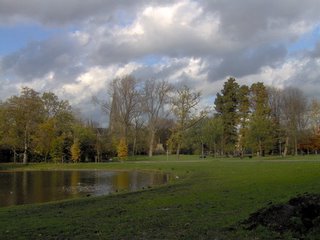

Vondelpark, known as Amsterdam's lung, was created in 1865 by the Association for the Riding and Walking-Park. While the members genuinely wanted recreational space for thousands of working poor the creation of Vondelpark hiked local real estate values and led the wealthy to build elegant homes for themselves around the lung.

One in particular caught my eye—the most perfect climbing tree I’ve ever seen, festooned with kids whose generations had polished the tree's bark their shoes and backsides.
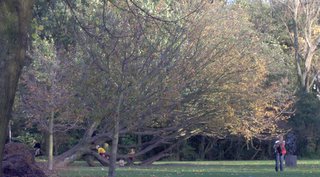
There are a number of “must dos” in A-dam. I managed to miss two. I didn’t visit the Red Light District, so I’m afraid those who read this far hoping for photos of scantily clad business ladies sitting in windows will be disappointed. I also missed the Anne Frank house. I did spend a half day each in the Van Gogh Museum and the Rijksmuseum.
What they say is true -- reproductions do not prepare you for the reality of Van Gogh and the

energy of his brush work.
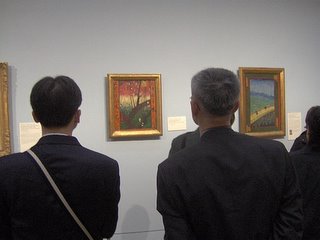
In both museums visitors can get close enough to touch the paintings. In most cases there is no glass between you and the art. It is actually nerve wracking to watch instant art experts pointing at various works, their fingers, pencils and pens poised mere centimeters above a Rembrandt. While tolerant Dutch security guards hover ready to eject troublemakers, after a time I began to wonder: are these originals or just perfect copies. Would the Dutch allow an unpredictable public to get close enough to damage these world treasures?
Of course Amsterdam wouldn’t be A-dam without its coffee shops. How do you know when you're near? You have to look for the signs.

They actually do serve coffee and tea as well as other legal drugs. And while the clientele is predominately of the dreaded pierced tattooed sort, there were not a few grayer, more sedate customers along with the occasional mom-and-pop tourist, sipping coffee and taking it all in with fascinated disapproval.
In the end it might be best to just buy the T-shirt. It says it all.
 This morning Regensburg awoke to bitter cold and falling snow. Inner child awakened, I dressed quickly and dashed out.
This morning Regensburg awoke to bitter cold and falling snow. Inner child awakened, I dressed quickly and dashed out. 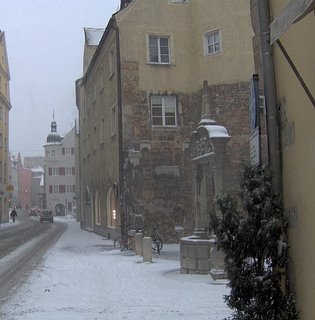

 Traffic of every description—cars, buses, bicycles— slipped and slid through the streets. An elderly man took a fall right in front of the altestadt bus and was pulled out of danger by two bystanders as the driver hit the brakes and the bus skidded to a halt only a few yards from the bicyclist.
Traffic of every description—cars, buses, bicycles— slipped and slid through the streets. An elderly man took a fall right in front of the altestadt bus and was pulled out of danger by two bystanders as the driver hit the brakes and the bus skidded to a halt only a few yards from the bicyclist.









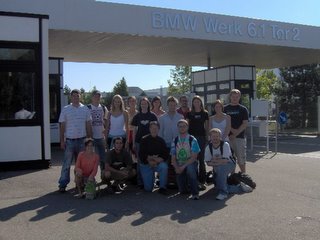
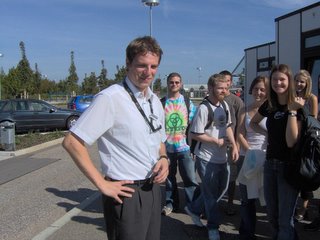
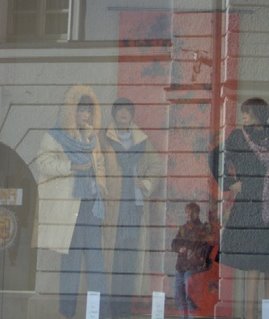

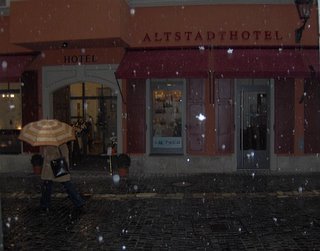

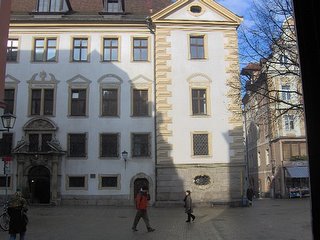 Two hours later the switch is thrown again. Cue the clouds! Okay, let’s have the snow! Roll ‘em. Laßt ihm scheien, laßt ihm scheien, laßt ihm scheien.
Two hours later the switch is thrown again. Cue the clouds! Okay, let’s have the snow! Roll ‘em. Laßt ihm scheien, laßt ihm scheien, laßt ihm scheien. 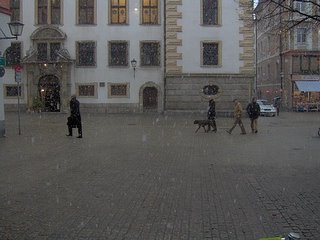



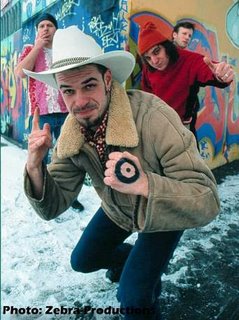
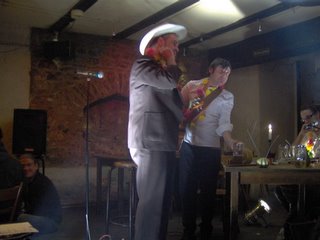

 In 1957 my family was stationed in Germany and we visited Amsterdam. I have vivd memories of the canal tour in the glass-roofed boats, of white lace curtains in the hotel, and of visiting fields of tulips where windmills sails turned in the sun. That I can remember these thing so well is noteworthy because I have trouble remembering last year. So naturally I had to visit to see if my memory was accurate. I was surprised that it was and how much more came back to me.
In 1957 my family was stationed in Germany and we visited Amsterdam. I have vivd memories of the canal tour in the glass-roofed boats, of white lace curtains in the hotel, and of visiting fields of tulips where windmills sails turned in the sun. That I can remember these thing so well is noteworthy because I have trouble remembering last year. So naturally I had to visit to see if my memory was accurate. I was surprised that it was and how much more came back to me. 









 Another A-dam oddity is its lack of anything like a local cuisine. Tourists hear about A-dam’s international restaurants because no national dishes exist—unless one counts various sorts of smoked fish offered by occasional vendors. Sort of a Hanseatic salted sushi.
Another A-dam oddity is its lack of anything like a local cuisine. Tourists hear about A-dam’s international restaurants because no national dishes exist—unless one counts various sorts of smoked fish offered by occasional vendors. Sort of a Hanseatic salted sushi.




















